Function 5: Schedule Performance Reporting
In addition to the wide variety of the schedule performance reports that could be either directly generated from the planning and scheduling or by interactive dashboard reporting tools like MS Power BI, there is still a requirement to generate schedule performance reports that combine the data from the planning and scheduling software and the project management information system (PMIS) software like PMWeb.
The Project Schedule Dashboard is the report that provides an overall performance status of the project schedule. It provides a summary status of the project’s milestone dates, earned value management (EVM) performance status based on the weight value assigned to project schedule activities, the status of time impact analysis (TIA) been carried out, the status of submitted extension of time (EOT) requests, the summary of schedule-related meetings, the progress curve showing planned and actual performance and a histogram comparing planned to spend resources.
PMWeb allows enabling the reader to drill down in the dashboard for more details on each of the reported performances. For example, the reader can drill down to the Time Impact Analysis (TIA) to have more details on the time impact analyses being done on the project. The same applies to the Extension of Time (EOT) requests, schedule-related meetings, milestone dates, and others.
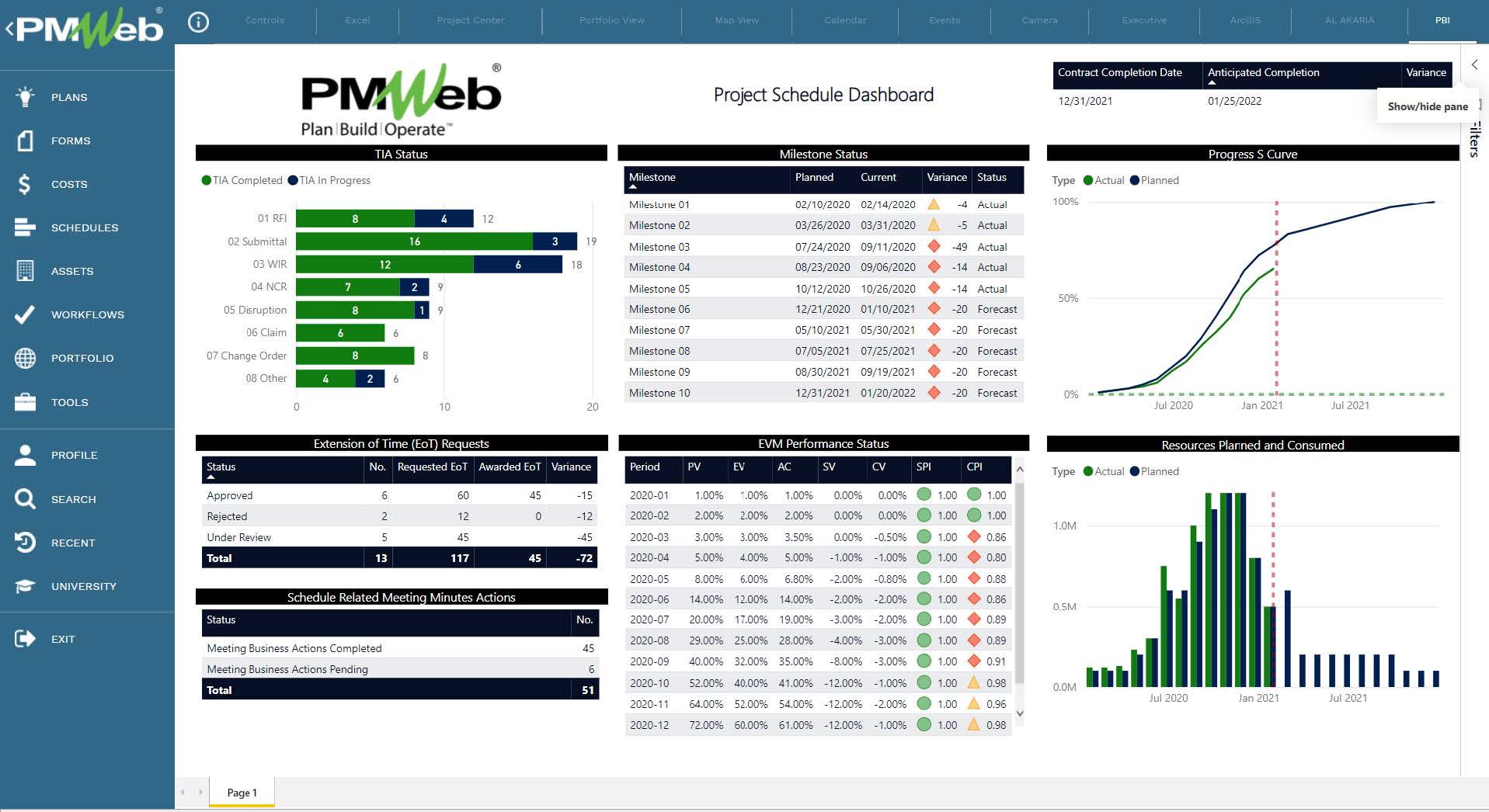
For those who might need to have more details on the project’s milestone dates, the PMWeb custom form builder allows creating a template to capture the progress narrative of each milestone activity. The report has a table to capture the details of all milestone activities, along with the narrative explaining their status, including delays and the contracting party responsible for the delay. This activities list will be available from the linked schedule imported to the PMWeb schedule module. This is also where PMWeb allows setting which schedule version should be considered as the active version to be used by the different PMWeb processes.
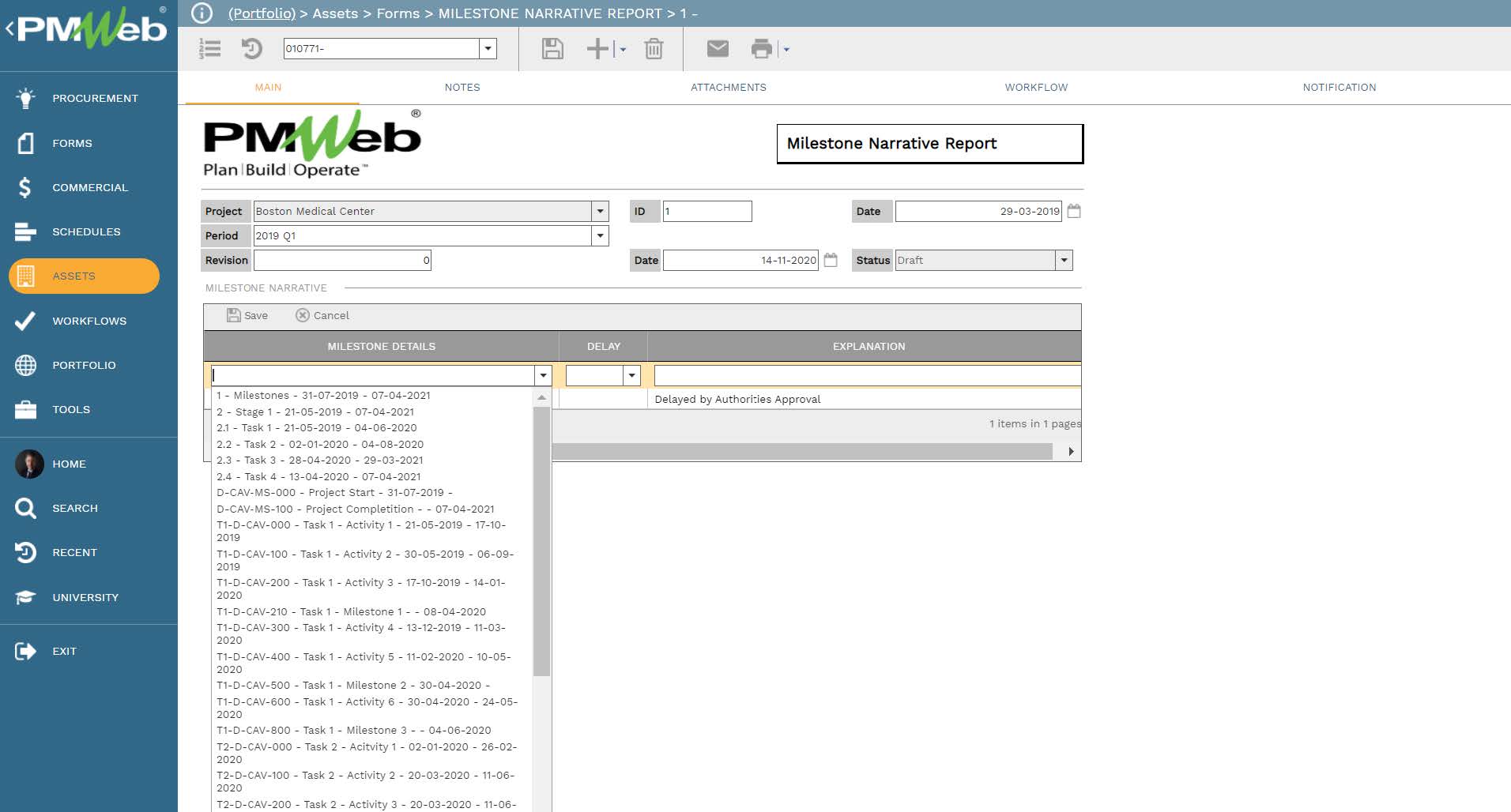
The imported project schedule update and the Milestone Narrative Form become the basis for creating the project’s schedule milestone report. This report lists the status of the milestone activities that should be completed in the current progress period and the milestone activities scheduled to be completed in the next progress period. For each milestone activity not completed in the current period or expected to be delayed in the next period, the reason for the delay must be provided, along with a narrative to explain the reason.
The report includes visuals to summarize the activities completed and delayed in the current period and the reason for the delay. As well, the report includes an overall view of the project’s planned completion date and forecasted finish or completion date. In addition, it shows the current project delay by reporting the Total Float value. The summarized information also includes the project’s current percent complete, the total number of the project’s milestone activities, those completed to date, and the remaining milestone activities to be completed.

The 4D Schedule reporting is another type of report that could be required on construction projects. Although the concept of 4D scheduling has been available for capital construction projects for more than a decade, nevertheless, even today, 4D scheduling is mainly intended for professional planners or stakeholders who know how to run these software applications and are willing to pay for the investment associated with having access to such solutions.
On the other hand, many other project stakeholders, executives, and non-executives are keen to use the principle of 4D scheduling to better visualize and understand the progress achieved on the project, compare planned with actual progress, and understand delays in activities. Most of these stakeholders neither have the knowledge and skills of planning and scheduling engineers nor do they want to learn how to use or invest in acquiring the software applications needed for this 4D schedule analysis. Nevertheless, the one thing which they do not comprise is that 4D schedule reporting must be based on trustworthy and traceable sources of data. Furthermore, these stakeholders do not accept raw 4D schedules not accompanied by an explanation of what is being shared and presented to them.
The proposed 4D Schedule Delay Analysis Report and all other 4D Schedule Analysis reports can be developed using the MS Power business intelligence (BI) and data visualization tool. The visual developed by KG-DEV, called 3DBI, displays the BIM model extracted from Autodesk Revit in MS Power BI. To ensure the project schedule activities are associated with the related BIM object or asset, the project schedule activity’s ID is added as one of the data fields in the Autodesk Revit data tables. The project schedule data and narrative for the delay and delay responsibilities is captured from PMWeb, the Project Management Information System (PMIS) used for this 4D Schedule Analysis report.

The project schedule data captured in the PMWeb schedule module becomes the basis for the data used in the 4D schedule reports. This data is extracted directly by MS Power BI. This ensures that the project stakeholders receive the 4D Schedule reports, or any other schedule reports, that are the baseline. The updated or revised schedules are formally submitted, reviewed, and approved before being shared with the project stakeholders.
PMWeb helps create the input form for the narrative text that is part of the 4D Schedule Analysis reports. It must be completed by the planning and scheduling engineer responsible for analyzing and reporting on the project delays. The content of the form can be configured to include all the fields that might be needed for the reports. Nevertheless, at the very least, it should include the progress period data date, contractor name, narrative text, total schedule delays to date, delays due to the contractor, delays not due to the contractor, and delays due to third parties, i.e., neither the contractor’s nor the project owner’s authorized representatives.
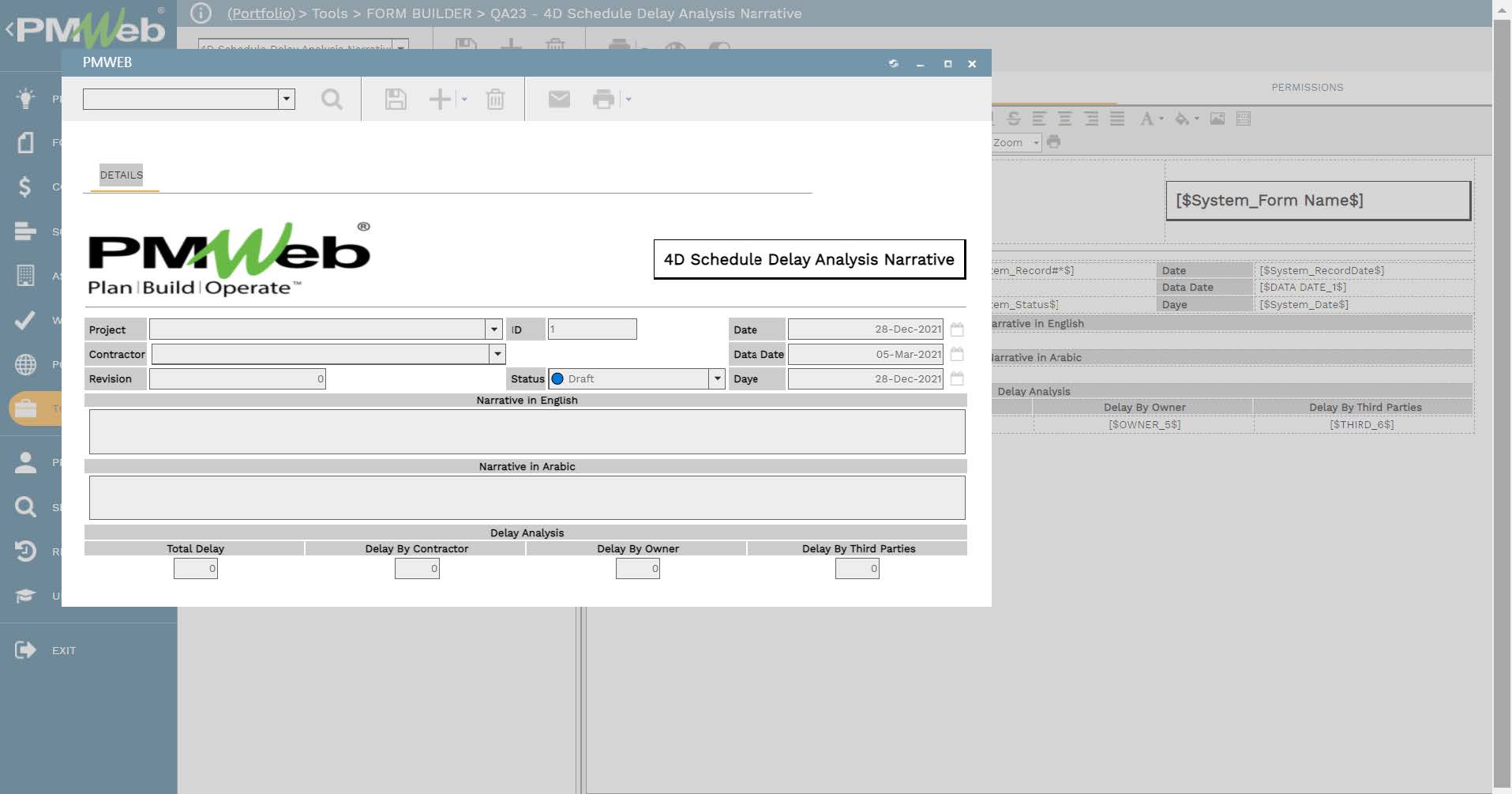
The data captured in PMWeb helps to update the information displayed in the 4D Schedule Analysis report as new schedule data becomes available at the end of each progress period. In addition, the report reader can select specific activities to be viewed in the report or choose the values of any other attribute defined in the report. In addition, selecting a BIM object from the BIM visual automatically adjusts the report’s content to reflect the data associated with the selected PMWeb object or asset.
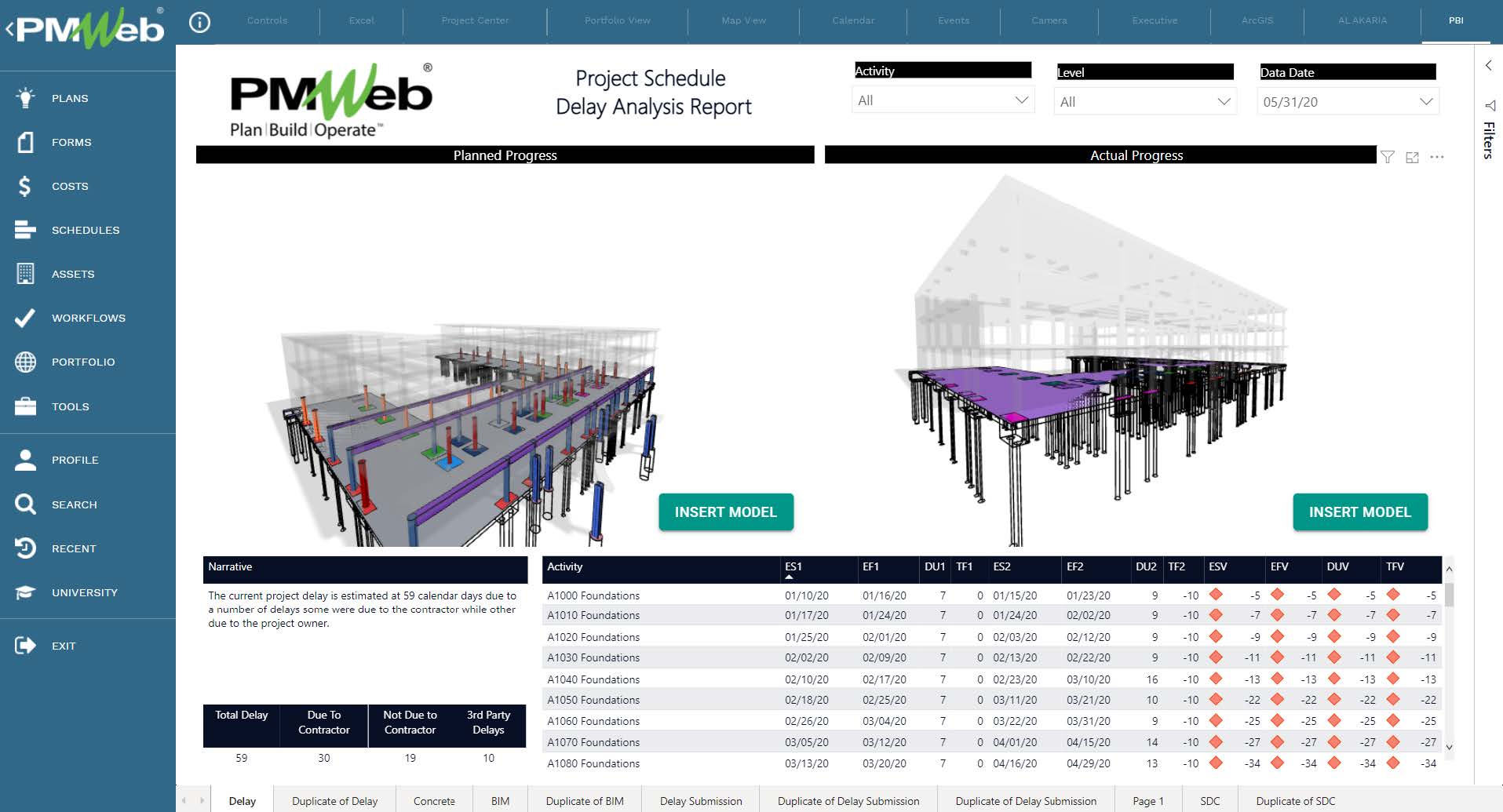
Another schedule reporting requirement is for executive stakeholders of entities involved in delivering linear capital construction projects. For those stakeholders, they are always keen to have a single-page report that gives them an easy-to-read and understand single version of the truth of how a project is performing. Linear projects include highways, roads, railways, metros, gas, oil, water, wastewater pipelines, services tunnels, culverts, and transmission lines. Usually, these projects include multiple segments or sections for which the activities to be performed at each segment or section are identical. The number of those activities, which depends on each linear project type, can vary between 10 and 20 activities.
For example, a pipeline project might consist of twelve sections or segments. Each section’s start and endpoints are defined by their geospatial coordinates of latitude and longitude values. The length of each section varies and usually depends on whether there is a need to build a structure like a pump room. For a pipeline project, the typical activities for each section might include clear and grub, grade, haul and string, bend, weld, coat, lower-in, trench, tie-ins, backfill, machine cleanup, and final cleanup.
This challenge can be easily addressed using PMWeb as the trusted platform to provide a single real-time version of the truth, a project’s performance information coupled with an interactive BI and data visualization tool like MS Power BI. With the many types of visuals used in MS Power BI to visualize and analyze the projects’ performance data captured in PMWeb, a map is also required like the one available from ‘Icon Map.’ The reason for selecting this map visual is that it allows showing each section’s start and endpoints in a linear project using the geospatial coordinates of latitude and longitude values.
The contents of the performance dashboard can be designed to read all progress details from the different business processes managed in PMWeb and the project’s schedule data, which could be done using tools like Primavera P6. Nevertheless, the main objective of this performance report is to provide senior executives with an overall performance status of the project and not replace the other reports that detail the performance status of the different business processes managed on the project to which they have access.
Therefore, it is highly recommended that the contents of this report be based on performance details provided by the project owner’s own project management team. The contents of the performance report should be completed in no more than an hour without sacrificing the quality and validity of the reported performance.
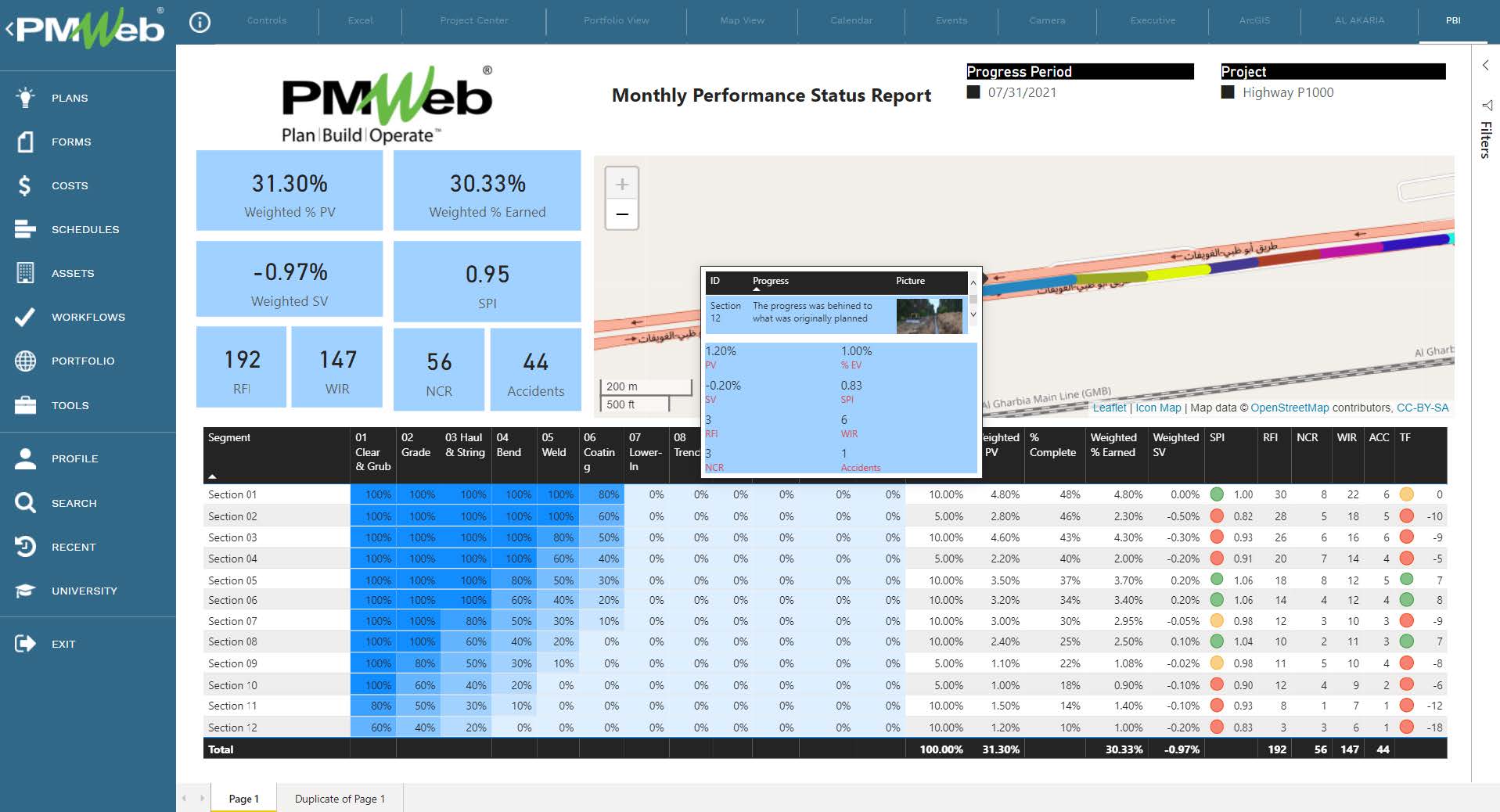
To achieve this, a custom form in PMWeb can be created to capture the progress details for each of the standard tasks for a linear project. The form has all sections of the linear project pre-defined. The planned progress percent complete for the current period and actual earned percent complete for the same period need to be provided by the assigned individual for each section.

Another schedule reporting requirement is for housing projects where the monitoring and evaluating of the progress of these projects needs to be associated with a map showing the location of these projects, with the option of displaying the project location as a point or polygon indicating the project boundaries. For each project, there is a need to show the planned and current start and finish dates, completion date delays, approved budget, approved adjustments, revised budget, pending adjustments, anticipated budget, actual funds spent or released to date, and balance to complete. In addition, each project has fields to identify the project delivery method and a status field to identify if the project is on track, on hold, not started, completed, and facing issues. The projects displayed in the report can be color-coded by the progress status.
Of course, additional details such as progress achieved, issues affecting the project, current progress photos, and other necessary information will also be reported. However, it should be recognized that this report is mainly intended for executive stakeholders assigned the responsibility of monitoring, evaluating, and reporting the performance of the housing strategic objective.
In the case of housing projects built in areas that require infrastructure projects for roads, electricity, sewage and water supply, facilities for schools, clinics, multi-purpose halls, and parks, details of these projects must be added to the report. These infrastructure and facilities projects are necessary to make those housing projects livable. The information for those projects will be limited to planned and current start and finish dates and completion date delays. In addition, if this option is selected, all projects must be displayed as polygons showing the boundaries of each project.
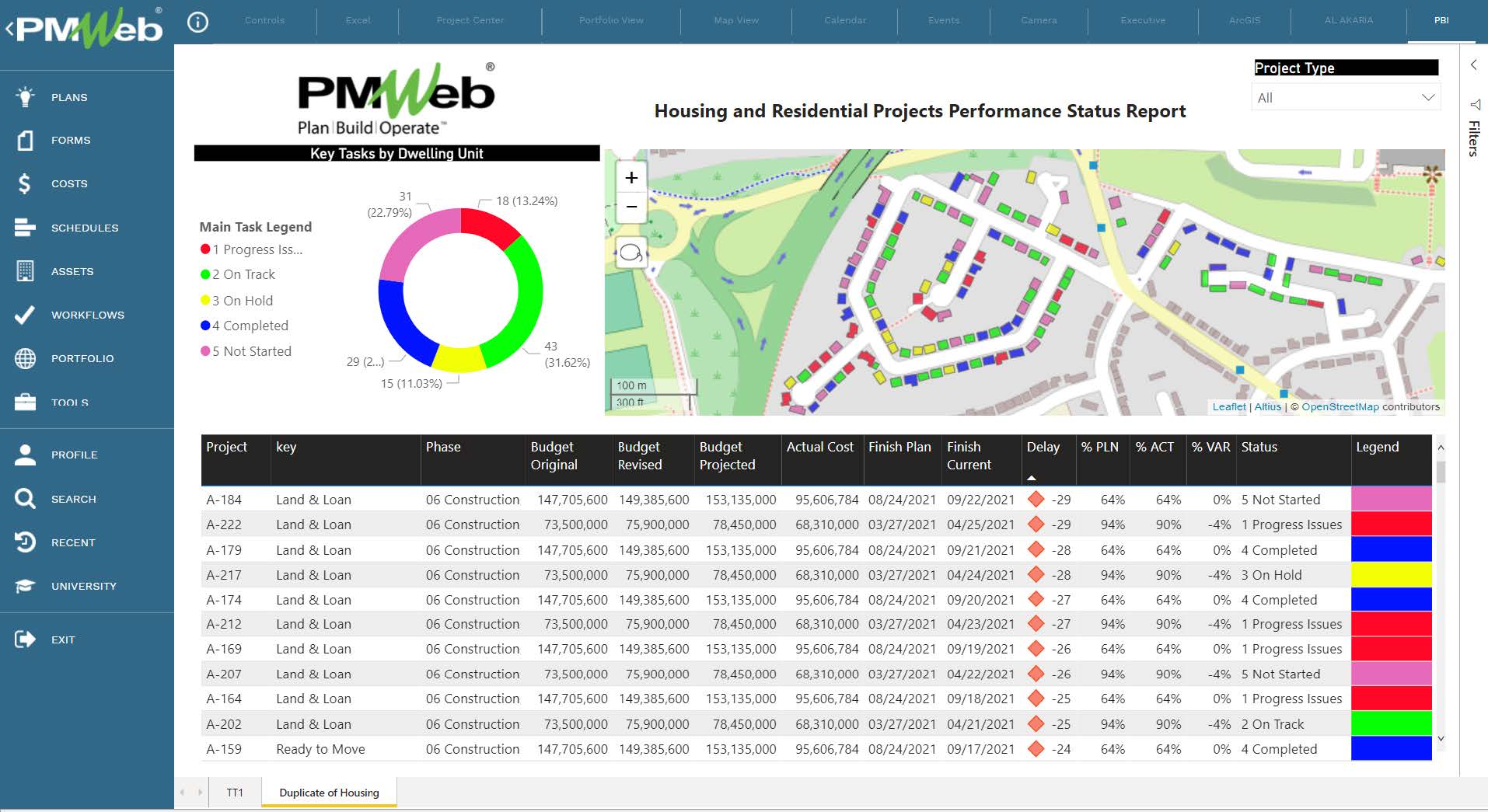
Using PMWeb, a single repository of all housing and residential projects can be managed, monitored, evaluated, and reported. The project module captures the details of all these projects, including their geospatial information and boundaries. Data that relates to each project’s built-up area, floor levels, and delivery method, among others, will also be captured.
Although the PMWeb Project Management Information System (PMIS) helps manage all project control system functions, nevertheless, the objective of the schedule progress performance status report is to provide senior executives with the overall status of how each project is performing. In particular, whether it will be delayed, run over budget, and/or have issues affecting its performance regardless of the project maturity level an organization has in managing capital construction projects. In addition, the projects could be managed and executed by entities other than the entity to which these executive stakeholders belong.
Accordingly, the PMWeb visual custom form builder allows creating a template to give access to each entity involved in delivering these housing projects. The progress report header includes the project name, progress report number and date, and the approval status of the progress report. In addition, the report should include the progress data date and the project’s performance status, which will be selected from a pre-defined list of values. Those values include progress issues, on track, on-hold, completed, and not started.
The report also includes a section for progress narrative and four tables to capture the details of the project schedule, physical progress, financial status, and the top five issues affecting progress. The schedule table includes fields for planned and current start and finish dates and delays. The physical percent complete is planned, and actual percent complete values is automatically calculated for the variance percent complete. The financial status includes the input fields for originally approved change orders, pending change orders, and the actual cost to date. The revised and projected cost values are automatically calculated. The issues table captures the top five issues that could impact project progress.
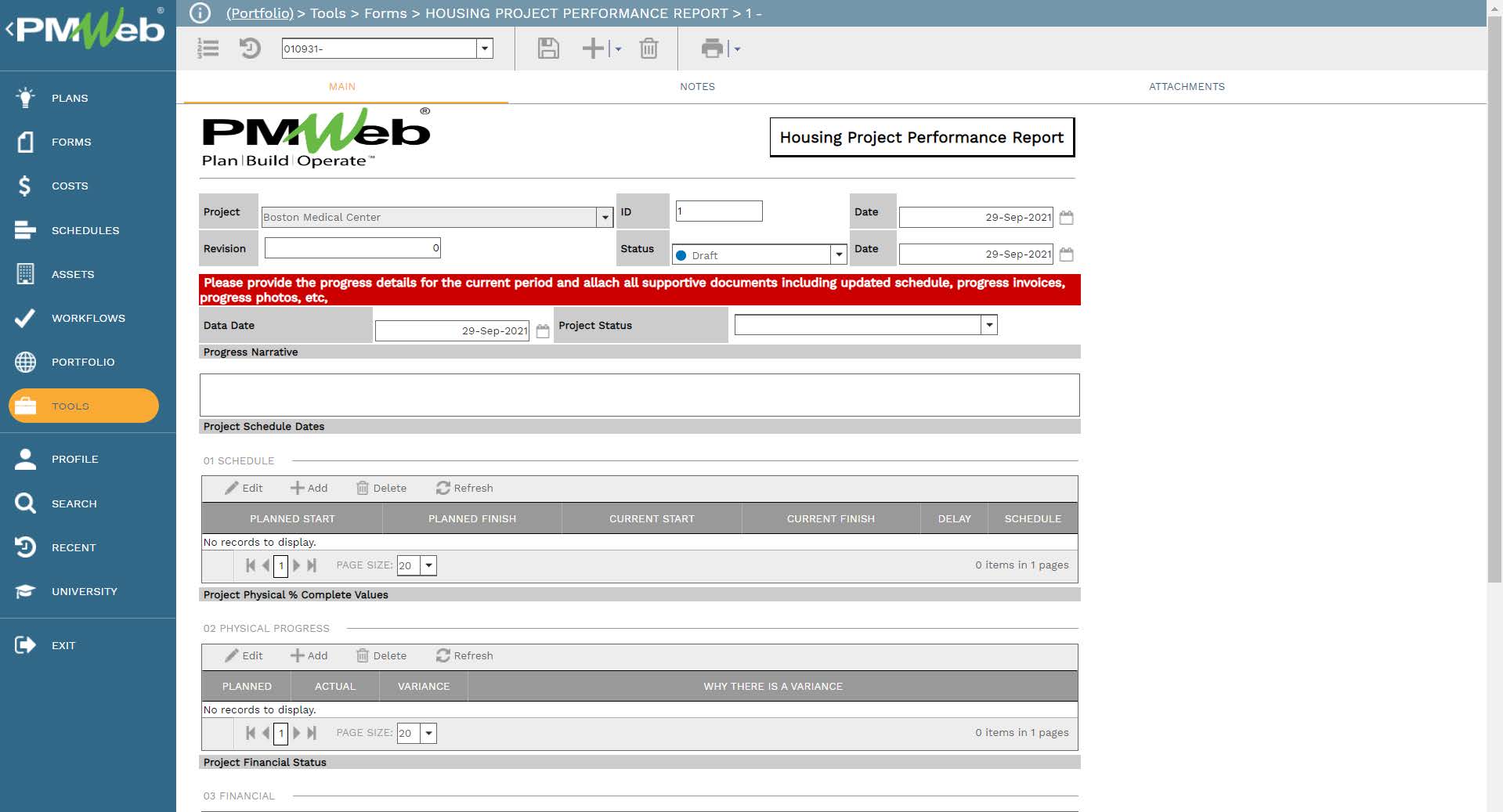
The performance report enables the reader to select projects by their performance status: progress issues, on track, on hold, completed, or not started, and by their delivery method: plot of land and zero-interest loan to build the house or read-to-live-in house or apartment. Of course, there is no limit on which selection filters to add or to the report’s design.

Furthermore, there is an option to create a progress card to provide details of each project’s progress that displays the progress narrative and progress photo. The content of the progress card can, of course, be designed to show the needed information and details. The progress card automatically displays any housing projects displayed on the map when it hovers over.
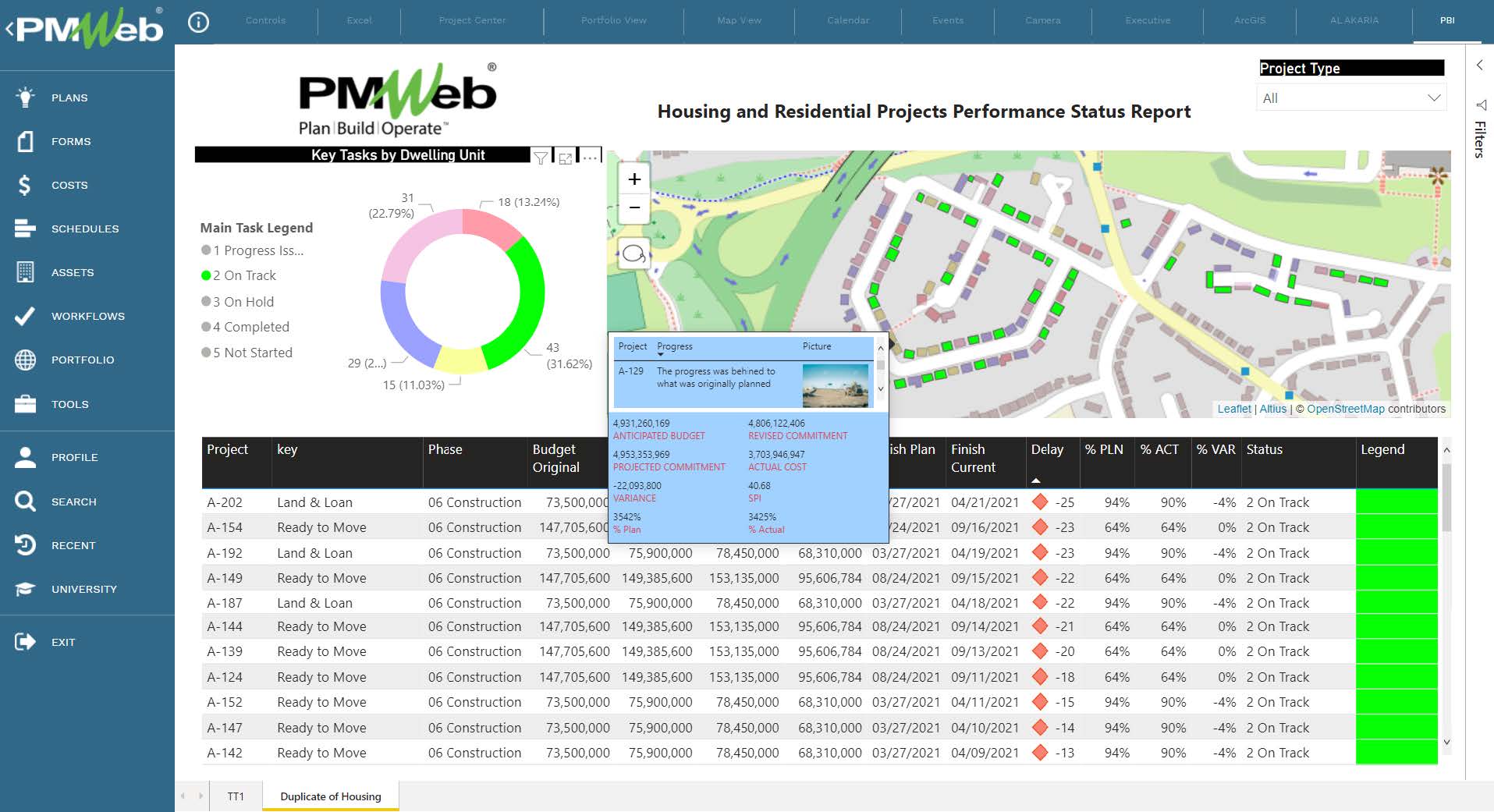
Reference
The content of this article was extracted from the book titled “Let’s Transform: Enabling Digital Transformation of Capital Construction Projects Using the PMWeb Project Management Information System – 2nd Edition”. The book was written by the author of the posted article, Bassam Samman.
The book provides project owners with oversight on how technology available today can support their efforts to digitally transform the management of their projects’ portfolios. For each capital project life cycle stage, PMWeb is used to detail how the relevant project management business processes can be digitalized to enforce transparency and accountability in delivering projects. In addition, MS Power BI was used to show how the real-time, trustworthy data captured in PMWeb can be aggregated, modeled, monitored, evaluated, analyzed, and reported at anytime, anywhere using any device.



